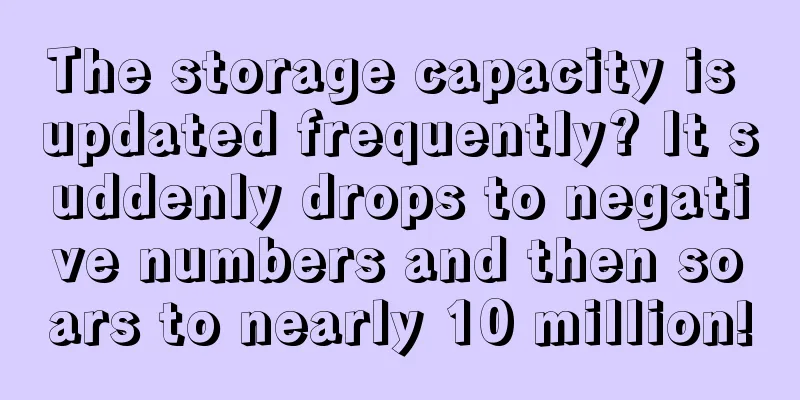There have been some strange trends in the cross-border circle recently. First, suppliers manipulated the market to make money from sellers, and then sellers and their peers started a price war. Tracing back to the origin of all this, it seems that it is closely related to the new policy on storage capacity restrictions .
Since Amazon announced its inventory restriction policy, sellers have been restricted in every aspect when shipping goods, and are constantly worried by the total inventory volume that fluctuates like an electrocardiogram. The storage capacity has been expanded to 10 million! Is it a phishing operation or a system bug? While many sellers are complaining about the continuous decline in inventory capacity, one seller recently made a Versailles-style statement: Amazon has expanded its inventory of clothing and shoes to 10 million , far exceeding the original capacity.
▲ The picture comes from Zhiwubuyan
It is reported that Amazon initially provided a stock capacity of 1,000 units. After the 800 units shipped by the seller were picked up by UPS and tracked by Amazon, the stock capacity was further expanded to 3,000 units. Afterwards, the seller immediately created two groups of 2,240 shipments, and the inventory capacity soon soared to 9,999,999. Although the seller wanted to strike while the iron was hot and create 4,000 shipments, he was hesitant, fearing that the shipments would be rejected or cancelled midway. ▲ The picture comes from Zhiwubuyan
The seller was puzzled by this. While the inventory capacity of most sellers has been decreasing, his inventory capacity has suddenly soared. Is this Amazon's sting operation or a bug in the system? Faced with the seller's "unreachable" storage capacity, some sellers called it Versailles and joked that the reason for not being able to ship was found. It turned out that all the inventory slots were moved to this seller. ▲ The picture comes from Zhiwubuyan
However, some sellers said that similar situations have occurred before, and they will automatically return to their original state after a month. It suddenly dropped to negative numbers! Sellers reported that the inventory capacity was updated frequently
However, this seller is just one of the chosen ones among thousands, and reduced storage capacity and restricted delivery are still the main themes of life for most sellers today.
Recently, a seller reported that his shipment was cancelled by Amazon after it was shipped . It is reported that after the seller created the shipment and sent it out on the 25th, Amazon restricted the inventory that night, and the shipment was also cancelled two days later. ▲ The picture comes from the seller communication group That is to say, once Amazon updates the inventory limit, the shipment will be canceled even if it has already been sent. In fact, Amazon has been updating sellers’ inventory capacity more frequently recently, with various restrictions being introduced. A seller on the US site said that his inventory capacity dropped to a negative number at the end of May, and the number of items available for shipment was 0. ▲ The picture comes from Zhiwubuyan Another seller on the UK site said that the inventory capacity was previously updated once a week, but this week it has been decreasing almost every day, and has now dropped three times in a row. ▲ The picture comes from the seller communication group
Amidst the complaints, sellers on the Canadian site reacted particularly strongly. According to one seller, his inventory dropped sharply to 1,500, and there were only 20 quotas for new products, which also caused a chain reaction of greatly increased shipping costs. ▲ The picture comes from the seller communication group When the storage capacity is small, the order quantity will increase significantly? In addition to the above situations, a seller who is also based in the Canadian site reported that when inventory is low, the number of orders will increase significantly.
▲ The picture comes from Zhiwubuyan
The seller said that not long after he started his business in Canada, he started to receive bad news. From reducing storage capacity to reducing the number of individual ASINs, the total inventory has dropped from 75 to the current 20. The seller sent out a batch of goods some time ago, one batch of 75 and the other batch of 20. The next day, the two products with a quantity of 20 were quickly ordered, but the other batch of 75 was not delivered. Delighted, the seller immediately turned on automatic advertising for both batches of goods. In the following days, the batch with smaller inventory continued to sell steadily despite the gradual price increase, and was soon sold out. After summarizing his experience, the seller believes that Amazon obviously wants him to ship more goods, thereby restricting his traffic and forcing him to run more advertisements to cope with it. In addition, many sellers have said that when the inventory capacity is too low, the order volume will increase accordingly. According to feedback from a seller, his inventory capacity was halved from 20,000 to 10,000, and then increased from 10,000 to 15,000. However, sales volume has doubled compared to before. Amazon's current mechanism is really confusing. ▲ The picture comes from the seller communication group
The inventory capacity fluctuated and replenishment was repeatedly restricted, and many sellers suspected that Amazon had technical problems. In response to such accusations, the Amazon forum moderator denied it and said that they continuously evaluate and update replenishment restrictions based on a combination of multiple factors. What is clear is that Amazon's inventory capacity has changed more frequently recently. Many sellers have been trying to outsmart Amazon in order to break through the shipping restrictions, but at the same time they also need to be wary of risks such as receiving red flags and shipments being canceled midway.
|










